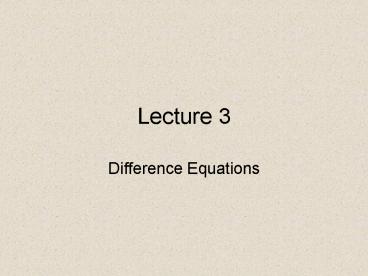Difference Equations PowerPoint PPT Presentation
1 / 30
Title: Difference Equations
1
Lecture 3
- Difference Equations
2
Non-Linear Difference Equations
- Where f depends on a non-linear combination of
its arguments - In general there are no analytic solutions
- We will consider 1st order equations
3
Non-Linear Difference Equations
- Steady state
- Suppose we have a difference equation
- An equilibrium solution
- No changes in the system
- Here is the average fixed point and
satisfies
4
Stability
- Require
- Example
- Consider
- Find steady states and stability
5
Stability
6
Stability
- Therefore, there are two steady state solutions
- Where is stable
- is not stable
- Lets look at a graph of the steady state
solutions
7
Steady State Solutions
8
Stability
- Exercise
- Initial conditions
- What happens if x0 0?
- What happens if 0lt x0 lt 1?
- What happens if x0 1?
- What happens if x0 gt 1?
9
Iteration and Cobwebs
- Cobweb diagrams are graphical representations of
the difference equation and the fixed points - Helps interpret the equation
10
Iteration and Cobwebs
- Steps
- First draw both yf(x) and yx on the axes
- Start at a given point on xn on x-axis, to get
xn1 - Start at point p on line yx and project
vertically to get point q on graph of yf(x) - From q project horizontally to get point r on yx
- Choose next point xn1 to be the x coordinate and
repeat above steps
11
Steady State Solutions
p
r
q
12
Steady State Solutions
13
Iteration and Cobwebs
- Get the long term behaviour
- Converges to a stable fixed point
- Or can be a divergent solution
- Can be used for linear and non-linear difference
equations - Cobweb is messy if we have a function that is
complicated
14
Example Logistic Growth
- In the first lecture of this class we looked at
exponential growth of an epidemic - We saw that there was exponential growth but,
this will only occur in the beginning of the
epidemic when there are many susceptibles per
infected individual to infect
15
Example Logistic Growth
- What other things may grow exponentially?
- Can this be true all of the time?
- Are there any limiting factors to growth of a
population?
16
Example Logistic Growth
- Many populations may initially experience
exponential growth, however, if resources become
depleted then there is competition for left over
resources, which will affect growth of the
population - We will now look at logistic growth
17
Example Logistic Growth
- Logistic growth
- Assumes that the expected number of offspring
decreases linearly with popn size - r intrinsic growth rate
- Measures whether a popn tends to grow (rgt0) or
shrink (rlt0) - K carrying capacity
- Measures the popn size at which the popn
produces exactly enough offspring to replace
itself
18
Example Logistic Growth
- Logistic growth
- nt number of offspring in generation t
19
Example Logistic Growth
20
Example Logistic Growth
- We can fit the logistic equation
- What are r and K?
- Find steady states and stability
- Draw cobweb
21
Example Logistic Growth
- r and K
22
Example Logistic Growth
- Find steady states and stability
- Stability
23
Example Logistic Growth
- Cobwebs
- But what happens if rgt2?
24
Systems of Difference Equations
- Linear system
- We will look at linear systems of the form
25
Linear System
- This can also be written as
- In general this is the way that we can write the
system - Where xk is a vector of n variables and A is an
nxn matrix
26
Linear System
- To find solutions we use
- ? is an eigenvalue
- v is an eigenvector
- We use these to find the stability and behaviour
of the system at the steady states
27
Linear System
- The behaviour of the system depends on the
magnitude of the ?s - Solution tends to 0 if
- Solution explodes if
- If eigenvalues are linearly independent
28
Systems of Difference Equations
- Non-Linear System
- Where f and g are nonlinear function of xn and yn
29
Non-Linear System
- The fixed points satisfy
- Stability depends on eigenvalues of a Jacobian
matrix
30
Systems of Difference Equations
- Predator Prey Example

